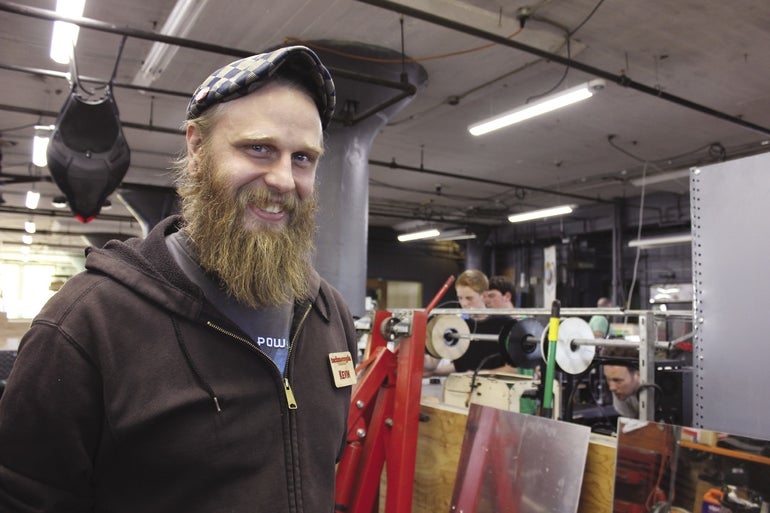On the sixth floor of a former production space near Worcester’s downtown, soaring views out of canted windows allow the clanking, clanging and whirring sounds of innovation and learning to float out into the city.
Technocopia’s new space in the Printer’s Building offers the equipment and area to carry out projects ranging from a retiree’s dream machine to incubating small startups while also providing educational classes to area grade and high school students. The home to advanced equipment such as 3D printers and laser cutters is part of a new crop of makerspaces that offer a breadth of equipment that would be beyond the means of the average tinkerer or even startup business to outfit, but through a membership process allow people to access an incredibly high level of equipment and knowledge.
But Technocopia is just one such makerspace popping up. In the last year, two new makerspaces opened – one at Quinsigamond Community College and a private space called the WorcShop – while Worcester Polytechnic Institute is building one as a premiere piece of a new building.
This all comes as schools and businesses are exploring the idea of a dedicated space to create and collaborate.
The exact equipment within makerspaces vary depending on the application they are built for, said Kenneth Fisher, a principal at Gensler architects in Boston and the project director for the Foisie Innovation Studio and Messenger Residence Hall at Worcester Polytechnic Institute. That building under construction now will have a makerspace play a prominent role in its configuration when it opens in 2018.
There are some universals, said Fisher, who characterized a makerspace as a place to investigate an idea physically through rapid prototyping using hand tools and machines such as 3D printers, laser cutters and CNC routers to create low-investment prototypes.
“It’s this idea of make, break, fail in high frequency cycling,” he said, adding the allure of a makerspace is it allows disparate people to work together.
Unlocking your tinkering potential
That was the goal for the Quinsigamond Community College Fab Lab that opened in February in the new QuEst Center. While manufacturing classes will make use of the space, the real allure is getting all kinds of students into the space. When students from artistic and engineering backgrounds get together, the result can be something that neither of them would have come up with individually.
“We are trying to open the mind of non-manufacturing students to what it takes to design a product and manufacture a product,” said Damian Kieran, QCC’s associate professor of manufacturing who manages the Fab Lab.
That same draw applies to the publicly-accessible Technocopia and the WorcShop makerspaces – two community-organized-and-operated, membership-based makerspaces. The WorcShop has an industrial bent and gives members access to massive metal-working machinery. It opened this year.
“Markets for products and services are pursued here,” said Randal Gardner, CEO of WorcShop, which also functions as an incubator. “You can start off in the makerspace on the cheap so you aren’t spending a lot of money on startup facilities … and once your sales become so much that the makerspace isn’t enough for you, then you go to the bank and get financing and get your own space.”
Developing young & old entrepreneurs
The same model is being used by WPI and QCC to help their students as they transition either into an entrepreneurial effort or the workplace. Even if students go right into the work environment, the skills of innovative thinking they can hone in a makerspace will serve them well, said Michael Ginzberg, the dean of WPI’s school of business.
“Large companies always talk about the percentage of their offering that didn’t exist five years ago,” said Ginzberg.
Education in makerspaces isn’t just limited to those placed in colleges and universities. Technocopia Co-founder Kevin Harrington said this is an inherent component of any makerspace, as a great deal of the equipment – such as 3D printers – has no official certification to prove people’s competency.
“The difference between what the tool share is and the educational piece is the empowerment of how to use those tools and become autonomous on them,” said Lauren Monroe, who recently combined her nonprofit organization Worcester Area Think Tank with Technocopia in the new space. “We brought over all of our youth programs that had been operating for eight years independently.”
This move is just one of the ways makerspaces in Worcester are extending past educational necessity and embracing this as part of their explicit mission.
Dropping cost, constant need
But understanding the function and educational drive of these Worcester makerspaces doesn’t explain their recent resurgence. The answer is nearly as varied as the people you ask. However, one strain that runs through those answers is cost: the exorbitant cost of trying to outfit all this equipment yourself makes membership attractive.
In Worcester, these places to build and do something with your hands may be tapping into the city’s history of manufacturing and innovation, said Ginzberg.
If part of the reason for the surge in these spaces is the past, in practice they are a part of the future. Having affordable spaces where students can grow businesses and make ideas a reality will retain them in the city, said Gardner.
However, the future of makerspaces themselves may be within businesses who can use them to access the collaborative thinking that offices promise but has been lost as departmental walls have built up and compartmentalized different employees, said Fisher, who is working on a makerspace within GE’s new Boston headquarters.
“It’s breaking down barriers and breaking down silos that have grown tighter and tighter in many research-based companies,” he said. “Why do you come to the office? You come there because need to interact with colleagues.”

